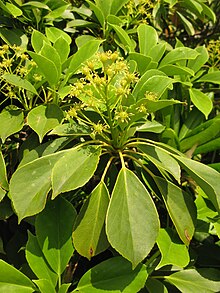Loading AI tools
Family of flowering plants From Wikipedia, the free encyclopedia
Trochodendraceae is the only family of flowering plants in the order Trochodendrales. It comprises two extant genera, each with a single species[1] along with up to five additional extinct genera and a number of extinct species.[2] The living species are native to south east Asia. The two living species (Tetracentron sinense and Trochodendron aralioides) both have secondary xylem without vessel elements, which is quite rare in angiosperms. As the vessel-free wood suggests primitiveness, these two species have attracted much taxonomic attention.
| Trochodendraceae Temporal range: | |
|---|---|
 | |
| Trochodendron aralioides | |
| Scientific classification | |
| Kingdom: | Plantae |
| Clade: | Tracheophytes |
| Clade: | Angiosperms |
| Clade: | Eudicots |
| Order: | Trochodendrales Takhtajan ex Cronquist |
| Family: | Trochodendraceae Eichler |
| Genera | |
| |
This section may be too technical for most readers to understand. (October 2020) |
Tetracentron and Trochodendron are deciduous or evergreen trees, which grow to between 20–30 m (66–98 ft) tall, with Trochodendron sometimes sporting umbrella-shaped branches.
Pollination is probably myriophyllous, even though Tetracentron shows a clear anemophilous syndrome. The pulverulent seeds are dispersed by the wind (anemochory). Trochodendron is present in both protandrous and protogynous forms that are self-compatible.
The plants are found in wooded formations, Trochodendron between 300 m and 2.700 m above sea level and Tetracentron between 1.100 m and 3.600 m above sea level.
Flavonoids (quercetin and kaempferol) and proanthocyanidins (cyanidin and delphinidin) are present. Epicuticular waxes are basically composed of nonacosan-10-ol.[citation needed] Tetracentron contains chalcones or dihydrochalcones. Trochodendron contains myricetin. Ellagic acid is absent.
Trochodendron and the fossil genus Eotrochion are known from the Paleocene of Wyoming, which constitute the oldest records of the family.[2]
A diverse assemblage of trochodendraceous species have been described from the Eocene Okanagan Highlands in British Columbia and Northeastern Washington. The monotypic genera Paraconcavistylon and Pentacentron are accompanied by Tetracentron hopkinsii and the Trochodendron infructescence morphospecies Tr. drachukii plus the foliage morphospecies Tr. nastae.[3][2]
The fruit and wood genus Nordenskioeldia, along with the associated leaf morphogenus Zizyphoides have been considered part of Trochodendraceae, though phylogenetic analysis by Manchester et al (2020) suggested they might be better placed as a basal stem lineage in the Trochodendrales, rather than as a crown group member of the family Trochodendraceae.[2]
The Trocodendraceae are a group of flowering plants that include the clade Eudicotyledoneae. In previous systems they have been related with the Cercidiphyllaceae and the Eupteleaceae, with which they share some characteristics that can be considered symplesiomorphic or convergent and that have been excluded from the order Trochodendrales because of molecular data leaving the Trocodendraceae isolated. Based on molecular and morphological data, the APW (Angiosperm Phylogeny Website) considers that it constitutes the only family in the Order Trochodendrales (cf. AP-website).
The current classification of Trochodendraceae is the APG IV system published in 2016, which maintains the circumscription of Trochodendraceae used in the APG III system published in October 2009. Unlike the APG and APG II systems, the later systems place the family as the only family in the order Trochodendrales. They also includes Tetracentron, synonymizing Tetracentraceae fully with Trochodenraceae.[4][5]
The APG II system, of 2003 retained the classification used in the 1998 APG system recognizing Trochodendraceae as a family. APG and APG II did not place the family in an order, leaving it among the basal lineages of the eudicots. Both APG systems accepts this as a family of two modern species, but it does allow the option of separating out the family Tetracentraceae.
This segregation would lead to two families with one species each: Tetracentraceae with Tetracentron sinense and Trochodendraceae with Trochodendron aralioides.
The Cronquist system, of 1981, accepted both Trochodendraceae and Tetracentraceae as families and placed these in the order Trochodendrales, in subclass Hamamelidae, in class Magnoliopsida.
The family includes two living genera with very different morphological characteristics:
Seamless Wikipedia browsing. On steroids.
Every time you click a link to Wikipedia, Wiktionary or Wikiquote in your browser's search results, it will show the modern Wikiwand interface.
Wikiwand extension is a five stars, simple, with minimum permission required to keep your browsing private, safe and transparent.